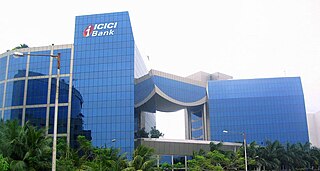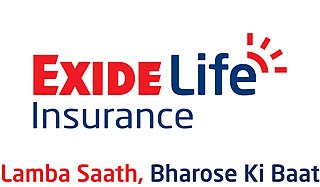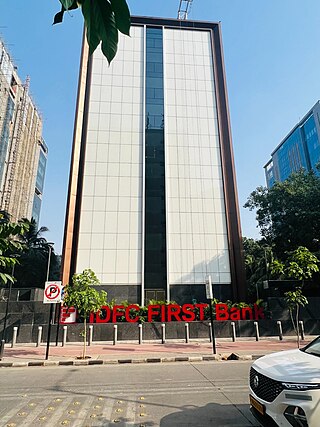
The ING Group is a Dutch multinational banking and financial services corporation headquartered in Amsterdam. Its primary businesses are retail banking, direct banking, commercial banking, investment banking, wholesale banking, private banking, asset management, and insurance services. With total assets of US$967.8 billion, it is one of the biggest banks in the world, and consistently ranks among the largest banks globally.

Financial services are economic services tied to finance provided by financial institutions. Financial services encompass a broad range of service sector activities, especially as concerns financial management and consumer finance.

ICICI Bank Limited is an Indian multinational bank and financial services company headquartered in Mumbai with registered office in Vadodara. It offers a wide range of banking and financial services for corporate and retail customers through a variety of delivery channels and specialized subsidiaries in the areas of investment banking, life, non-life insurance, venture capital and asset management.
Housing Development Finance Corporation was an Indian private sector mortgage lender based in Mumbai. It was the biggest housing finance company in India. It also had a presence in banking, life and general insurance, asset management, venture capital and deposits through its associate and subsidiary companies.

Modern banking in India originated in the mid of 18th century. Among the first banks were the Bank of Hindustan, which was established in 1770 and liquidated in 1829–32; and the General Bank of India, established in 1786 but failed in 1791.

Reliance Capital Limited is an Indian diversified financial services holding company promoted by Reliance Anil Dhirubhai Ambani Group. Reliance Capital, a constituent of Nifty Midcap 50 and MSCI Global Small Cap Index, is a part of the Reliance Group. It is amongst India's leading and most valuable financial services companies in the private sector. As on 31 March 2017, the net worth of the company stood at ₹16,548 crore, while its total assets as on the date stood at ₹82,209 crore. In Fortune India 500 list of 2018, Reliance Capital was ranked as the 77th largest corporation in India with 5th rank in 'Non-Banking Finance' category.
The IDBI Bank Limited is a development finance institution under the ownership of Life Insurance Corporation of India and Government of India. It was established in 1964 as Industrial Development Bank of India, a development finance institution, which provided financial services to industrial sector. In 2005, the institution was merged with its commercial division, IDBI Bank, forming the present-day banking entity and was categorised as "other development finance institution" category. Later in March 2019, Government of India asked Life Insurance Corporation to infuse capital in the bank due to high NPA and capital adequacy issues and also asked LIC to manage the bank to meet the regulatory norms. IDBI was put under Prompt corrective action of the RBI and on 10 March 2021 IDBI came out of the PCA. At present direct and indirect shareholding of Government of India in IDBI Bank is approximately 95%, which Government of India (GoI) vide its communication F.No. 8/2/2019-BO-II dated December 17, 2019, has clarified and directed all Central/State Government departments to consider IDBI Bank for allocation of Government Business. Many national institutes find their roots in IDBI like SIDBI, EXIM, National Stock Exchange of India, SEBI, National Securities Depository Limited.
Kotak Mahindra Bank Limited is an Indian banking and financial services company headquartered in Mumbai. It offers banking products and financial services for corporate and retail customers in the areas of personal finance, investment banking, life insurance, and wealth management. It is India's third largest private sector bank by market capitalisation after HDFC Bank and ICICI Bank. As of 31 March 2023, the bank has a national footprint of 1,780 branches and 2,964 ATMs.

Uday Suresh Kotak is an Indian banker and Founder of Kotak Mahindra Bank, where he currently serves as its non-executive director.
HDFC Bank Limited is an Indian Multinational banking and financial services company headquartered in Mumbai. It is India's largest private sector bank by assets and the world's fifth-largest bank by market capitalization as of August 2023, following its takeover of parent company HDFC. The Reserve Bank of India (RBI) has identified the HDFC Bank, State Bank of India, and ICICI Bank as Domestic Systemically Important Banks (D-SIBs), which are often referred to as banks that are “too big to fail”.

CIMB Group Holdings Berhad is a Malaysian universal bank headquartered in Kuala Lumpur and operating in high growth economies in ASEAN. CIMB Group is an indigenous ASEAN investment bank. CIMB has a wide retail branch network with 1,080 branches across the region.
The state of Karnataka, particularly the coastal districts of Dakshina Kannada and Udupi, historically and collectively known as South Canara, is called the cradle of banking in India. This is because seven of the country's leading banks, Canara Bank, Syndicate Bank, Corporation Bank, Vijaya Bank, Karnataka Bank, Vysya Bank and the State Bank of Mysore originated from this state. The first five in the above list of banks were established in the districts of Udupi and Dakshina Kannada. These districts have one among the best distribution of banks in India - a branch for every 500 persons. Between 1880 and 1935, 22 banks were established in coastal Karnataka, nine of them in the city of Mangalore.
Axis Bank Limited, formerly known as UTI Bank (1993–2007), is an Indian multinational banking and financial services company headquartered in Mumbai, Maharashtra. It is India's third largest private sector bank by assets and Fourth largest by Market capitalisation. It sells financial services to large and mid-size companies, SMEs and retail businesses.

Exide Life Insurance Company Limited was an Indian life insurance company. Exide Life Insurance distributed its products through multi-channels. The agency channel consisted of over 40,000 advisors who are attached to over 200 company offices across the country. The company had over 15 lakh customers and manages over INR 18,000 crores in assets. It had been operating since 2001 and was headquartered in Bangalore. It dealt with life insurance products, providing long-term protection and savings option.
Bandhan Bank Ltd. is a banking and financial services company, headquartered in Kolkata. Bandhan Bank is present in 35 out of 36 states and union territories of India, with 6,250 banking outlets and 3.26 crore customers. Having received the universal banking licence from the Reserve Bank of India, Bandhan Bank started operations on August 23, 2015, with 501 branches, 50 ATMs and 2,022 Banking Units (BUs). The Bank has mobilised deposits of ₹1,17,422 crore and its total advances stand at ₹1,15,940 crore as of December 31, 2023.
Small finance banks (SFB) are a type of niche banks in India. Banks with a SFB license can provide basic banking service of acceptance of deposits and lending. The aim behind these is to provide financial inclusion to sections of the economy not being served by other banks, such as small business units, small and marginal farmers, micro and small industries and unorganised sector entities.

ING Bank (Australia) Limited is a direct bank operating in Australia. It is a wholly owned subsidiary of the multinational Dutch bank, ING Group. ING in Australia holds an Australian banking licence as a foreign subsidiary company.

IDFC FIRST Bank is an Indian private sector bank formed by the merger of the banking arm of Infrastructure Development Finance Company and Capital First, an Indian non-bank financial institution.










